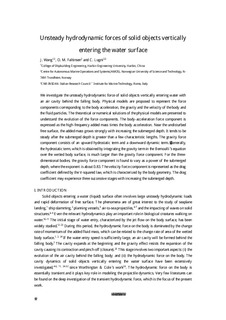| dc.contributor.author | Wang, Jingbo | |
| dc.contributor.author | Faltinsen, Odd Magnus | |
| dc.contributor.author | Lugni, Claudio | |
| dc.date.accessioned | 2019-12-19T08:13:53Z | |
| dc.date.available | 2019-12-19T08:13:53Z | |
| dc.date.created | 2019-08-28T09:39:24Z | |
| dc.date.issued | 2019 | |
| dc.identifier.citation | Physics of Fluids. 2019, 31 (2), . | nb_NO |
| dc.identifier.issn | 1070-6631 | |
| dc.identifier.uri | http://hdl.handle.net/11250/2634070 | |
| dc.description.abstract | We investigate the unsteady hydrodynamic force of solid objects vertically entering water with an air cavity behind the falling body. Physical models are proposed to represent the force components corresponding to the body acceleration, the gravity, and the velocity of the body and the fluid particles. The theoretical or numerical solutions of the physical models are presented to understand the evolution of the force components. The body-acceleration force component is expressed as the high-frequency added mass times the body acceleration. Near the undisturbed free surface, the added mass grows strongly with increasing the submerged depth. It tends to be steady after the submerged depth is greater than a few characteristic lengths. The gravity force component consists of an upward hydrostatic term and a downward dynamic term. Generally, the hydrostatic term, which is obtained by integrating the gravity term in Bernoulli’s equation over the wetted body surface, is much larger than the gravity force component. For the three-dimensional bodies, the gravity force component is found to vary as a power of the submerged depth, where the exponent is about 0.83. The velocity force component is represented as the drag coefficient defined by the V-squared law, which is characterized by the body geometry. The drag coefficient may experience three successive stages with increasing the submerged depth. | nb_NO |
| dc.language.iso | eng | nb_NO |
| dc.publisher | AIP Publishing, American Institute of Physics | nb_NO |
| dc.title | Unsteady hydrodynamic forces of solid objects vertically entering the water surface | nb_NO |
| dc.type | Journal article | nb_NO |
| dc.type | Peer reviewed | nb_NO |
| dc.description.version | acceptedVersion | nb_NO |
| dc.source.pagenumber | 18 | nb_NO |
| dc.source.volume | 31 | nb_NO |
| dc.source.journal | Physics of Fluids | nb_NO |
| dc.source.issue | 2 | nb_NO |
| dc.identifier.doi | 10.1063/1.5057744 | |
| dc.identifier.cristin | 1719373 | |
| dc.description.localcode | This is the authors’ accepted and refereed manuscript to the article. This article may be downloaded for personal use only. Any other use requires prior permission of the author and AIP Publishing. The following article appeared in Physics of Fluids 31, 027101 (2019) and may be found at https://doi.org/10.1063/1.5057744 | nb_NO |
| cristin.unitcode | 194,64,20,0 | |
| cristin.unitname | Institutt for marin teknikk | |
| cristin.ispublished | true | |
| cristin.fulltext | postprint | |
| cristin.qualitycode | 2 | |
